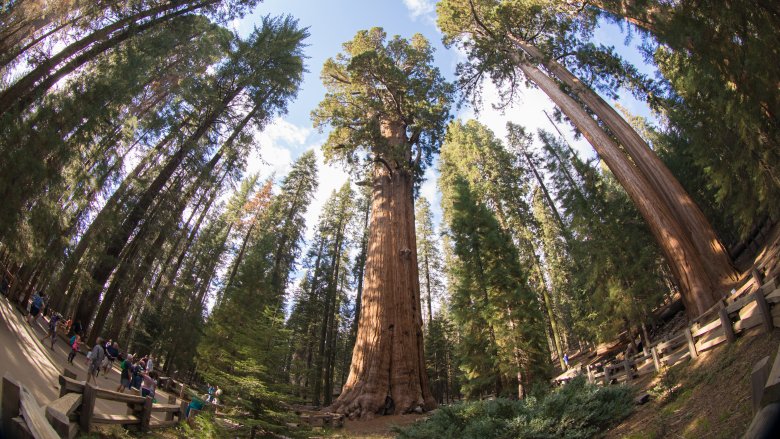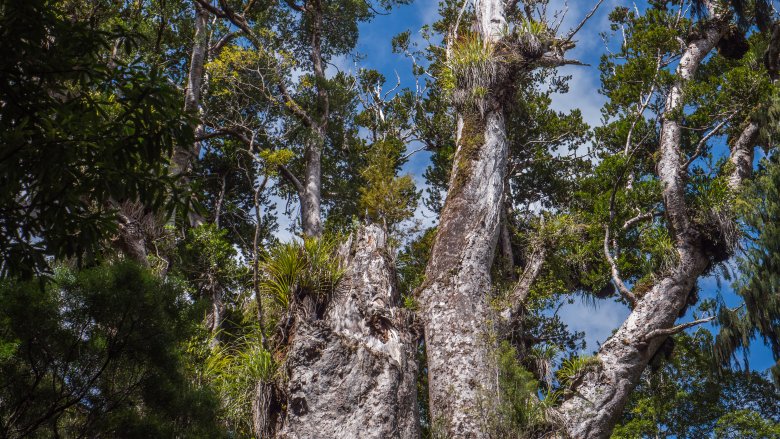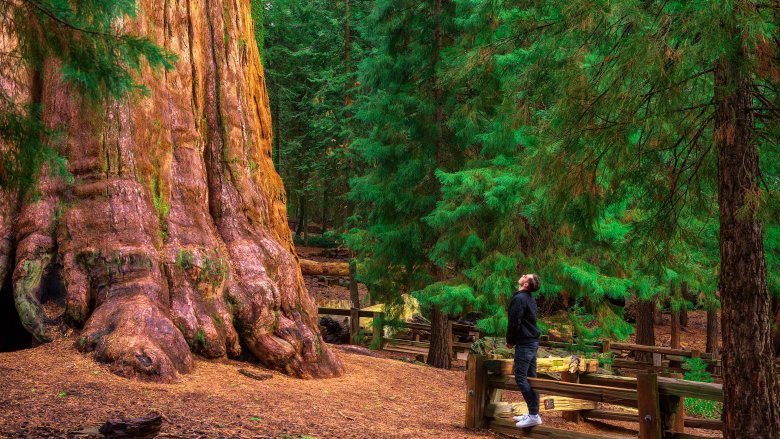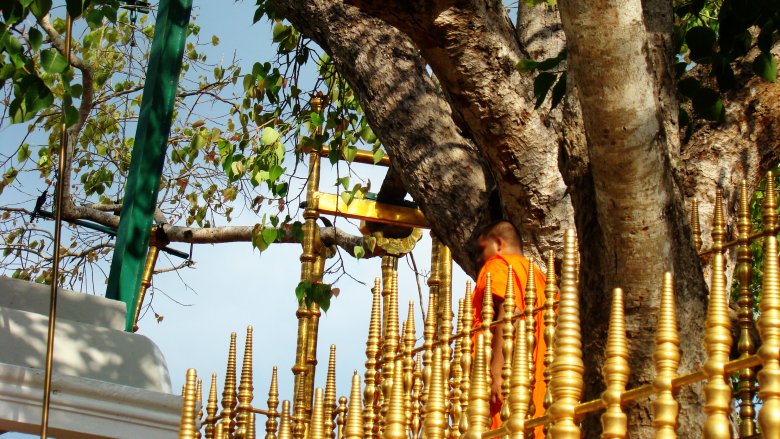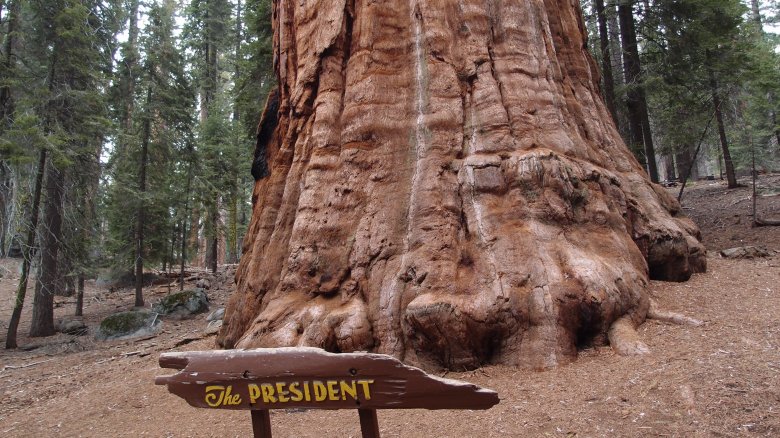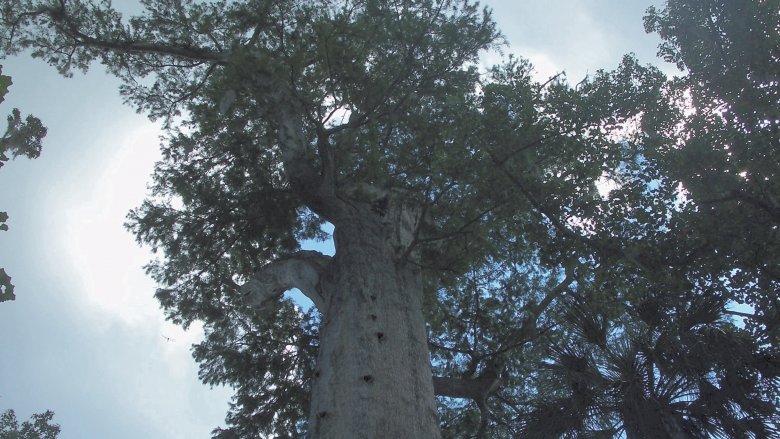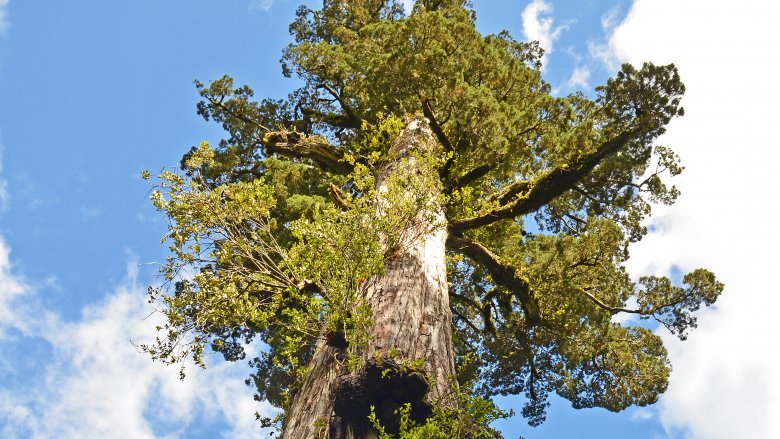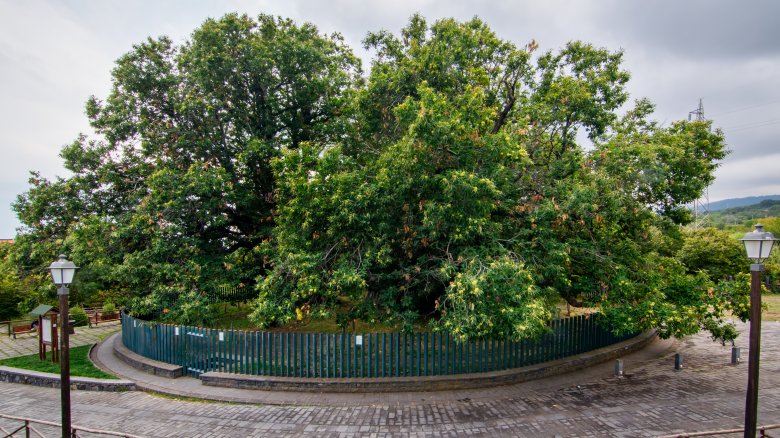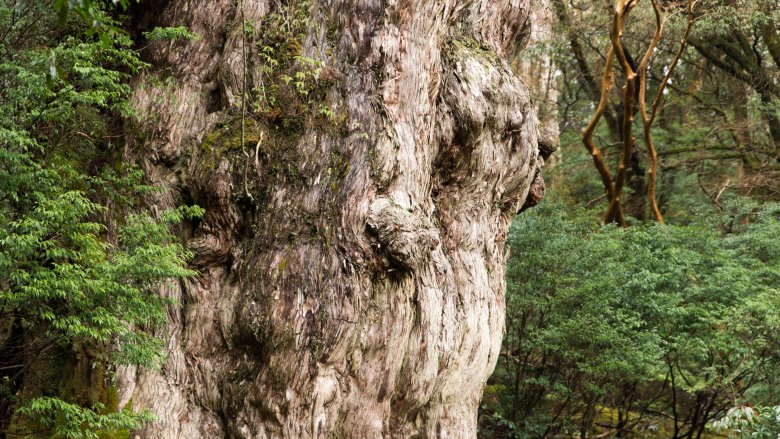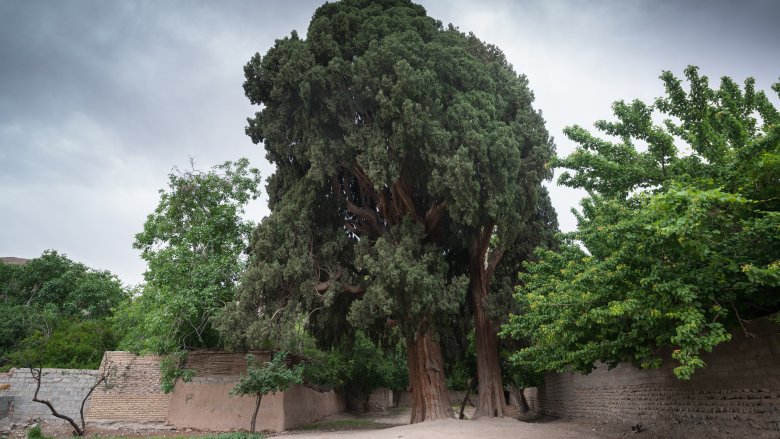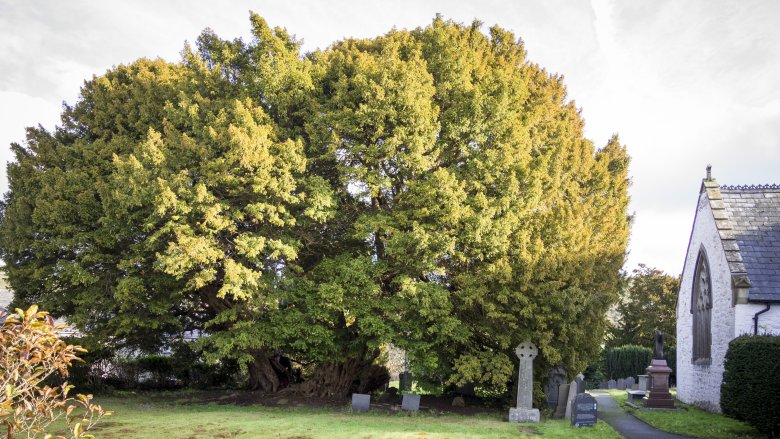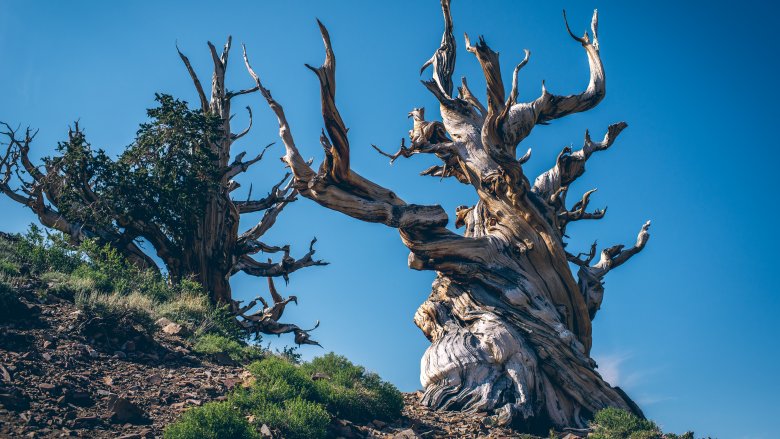These Are The Oldest Trees In The World
Humans are obsessed with longevity. We are in awe of centenarians, yet we lie about our age. We read up on diets that are proven to extend life, but then we eat cheesecake anyway. Occasionally, we even freeze our own heads, just in case some future scientist wants to sew it onto a creepy robot body or something. But no matter how hard we try, we've never been able to extend the average human lifespan much beyond 80 years or so, which is such a brief period of time in geological terms that, if they could, giant sequoias would probably laugh at us and make comments about how adorable we are.
Nothing on planet Earth lives longer than the oldest trees, unless you count the 500,000 year old bacteria scientists found in Siberian permafrost, but we'd really rather not. There are also a few clonal plant species that can live in excess of 100,000 years, but these are organisms that reproduce asexually and are constantly making new copies of themselves, so the individual plants aren't nearly as old as the collective organism. Trees reign supreme, and some trees live a particularly long time — long enough to witness the rise and fall of civilizations, though they're almost certainly too self-important to take much notice.
From legendary sequoias to mysterious yews, let's take a journey around the world to find the oldest trees and learn how they've stuck around so long.
This tree is as old as Jesus
Jesus never walked through the forests of New Zealand, but if he had, he might have seen a kauri tree sapling growing in the Waipoua Forest in the Northland region of the country. Today, that sapling is one of the oldest trees on Earth. According to the New Zealand Department of Conservation, the tree is called "Te Matua Ngahere," which means "Father of the Forest." In addition to being the oldest living kauri tree, it is also the second largest — 98 feet tall, which is about the same height as the Christ the Redeemer statue in Rio de Janeiro. It also has a broad trunk girth of nearly 54 feet, which is about 10 feet larger than the girth of a blue whale.
Kuari trees are evergreens, noted for having huge trunks with few branches between ground and crown. That means its lumber is valuable, because it makes long, straight planks with few knotholes. Historically, kauri wood was used to build houses and boats, and between 1840 and 1920 most of the older trees were cut down. Te Matua Ngahere got lucky, though. It was discovered during a 1928 road construction project, and the men who discovered it made the rare decision not to chop it down for money, which is what people usually do when they encounter large trees. Hooray for humans not killing all the kauri. Baby steps.
This tree is probably a little older than Jesus
According to Live Science, General Sherman is the largest tree in the world by volume — around 52,500 cubic feet, which is roughly equivalent to the amount of paper currently held in the New York State Archives. At 275 feet tall, it towers over California's Sequoia National Park, but don't be impressed just yet. General Sherman is actually more than 100 feet shorter than the world's tallest tree: Hyperion, a 600-year-old, 380-foot coast redwood located in California's Redwood National Forest. If you need something to compare that to, Hyperion is about 75 feet taller than the Statue of Liberty, from base to torch.
At around 2,200 years old, General Sherman is still growing, so in a thousand years or so it might actually catch up to Hyperion. In the meantime, it doesn't really need height to be impressive, because it has sheer bulk. General Sherman's branches alone are so huge that just one of them is bigger than almost every tree that grows east of the Mississippi. And you don't want to be standing under the thing when one of those branches decides to come down — in 2006, a falling branch crushed a brand new fence and walkway. So, if you do decide to visit General Sherman, it might be smart to look up every now and then, just in case.
We know the exact age of this ancient tree
For most trees, we can only guess at age. Sometimes core samples will give us dates that are pretty close, but not generally down to the exact year of planting. This tree is different. Called Jaya Sri Maha Bodhi, it's got a couple of claims to fame — it's the oldest tree with a known date-of-planting, and it is also the world's closest living link to the Buddha, the guy who achieved enlightenment under a fig tree. Jaya Sri Maha Bodhi isn't the fig tree, but it's about as close as you can get. According to Atlas Obscura, it was grown from a cutting of the sacred Bodhi tree, which was presented to the Sri Lankan king Devanampiya Tissa in 236 BC.
The tree has been cared for by Buddhist monks for more than 2,250 years, and as if a fig tree grown from the branch of the original Bodhi isn't impressive enough all by itself, the place where it grows has been adorned by statues, canals, walls, and various other shiny things. It's also been besieged by storms, vandals, and wild elephants. In 1985, the devotees who care for the tree were attacked by terrorists, who killed 100 people but left the tree itself more or less unscathed. Buddhists still make the pilgrimage to Anuradhapura to mediate under Jaya Sri Maha Bodhi. It may not be the Bodhi itself, but its definitely the next best thing.
Hail to the Chief
General Sherman may already hold the record for size, but as far as giant sequoias go, it's still just a millennial. Well, a couple of millennials, anyway. The oldest known sequoia is actually a full 1,000 years older than General Sherman. It's called the President, and it germinated 3,200 years ago, around the time of the Greek Dark Ages (which, by the way, was roughly 1,700 years before the European Dark Ages). According to the Vintage News, the President is so big no one has ever been able to capture a photograph of it in its entirety. At 247 feet, it's just a little bit shorter than General Sherman, though its tip shows evidence of lightning strikes, so who knows how big it might have become if those passing storms had been a little more merciful?
Researchers studying the tree have noted that the President is going to keep breaking records, because it's still growing at a rate of around one cubic meter a year, which is surprising, given how old it is. It also has around two billion leaves, and let's just say we really would hate to be tasked with counting them all (just kidding — that's an estimate). Anyway, its rapid growth rate combined with all those leaves means that the President is really good at processing carbon dioxide, making it a mighty warrior in the battle against climate change. Too bad we cut down most of the rest of the old growth forest... oops.
This tree is dead, but it's still worth a mention
Until 2012, a giant tree called "the Senator" held the titles of the oldest bald cypress in Florida and the fifth oldest tree in the United States. At 3,500 years old, the Senator was even older than the President, though not nearly as tall.
Despite the challenges of life in central Florida, the Senator kept on doing what trees do — namely, making shade, drinking sunshine and CO2, being big and awesome — until one night it mysteriously caught fire. According to NPR, officials initially blamed the fire on a lightning strike, noting that the tree appeared to have burned from the inside. The strike may have sparked a smoldering internal fire which eventually consumed the entire thing.
That was sort of an unsatisfying answer, though, and the reason why it was so unsatisfying is because it was nowhere near the truth. The Senator's killer was eventually apprehended after she admitted to a bunch of friends that she'd lit a fire inside the tree so she could see her crank pipe better. The fire got out of control, so she snapped a few pictures with her smartphone and ran off, just in case the police needed evidence to convict her. The next oldest tree in the neighborhood, "Lady Liberty," is just 2,000 years old, so it will be a while before we see another bald cypress tree like the Senator.
This tree is the oldest in South America
According to New Atlas, an alerce in Chile named Gran Abuelo (Spanish for "Great Grandfather") is South America's oldest tree. It probably won't surprise you to hear that most of the rest of the alerces on the continent were logged until there were hardly any of them left to log, because that's just what we humans do. The Spaniards were particularly interested in destroying alerce trees — they showed up in the 16th century to conquer, chop, and occasionally also burn, because who needs beautiful 3,500 year old trees when you can have a bunch of smelly cows instead?
Anyway, the few alerces that still exist in Chile are in remote locations, accessible only by driving an off-road vehicle across some rough terrain and then ferrying that vehicle across a river on a boat. Gran Abuelo is marginally easier to find — it's located in the Parque Nacional Alerce Costero 85 miles south of Valdivia. Still, to get there you have to drive over a poorly maintained dirt road, climb down a steep trail over roots and jagged rocks, and walk over a sketchy rope bridge. Take note, trees of the world: the secret to longevity is to grow somewhere that's a total pain to get to.
This tree laughs in the face of volcanic eruptions
The world's oldest chestnut tree grows on the side of a mountain. Not just any mountain — a volcano, and hardly a dormant one, having erupted no fewer than 65 times just in the last four hundred years. Also, the tree is less than five miles from the crater, making this not only one of the oldest trees in the world, but also one of the most badass.
According to Italy Magazine, the tree is called "The Chestnut Tree of One Hundred Horses." No one really knows how old it is — estimates say somewhere between 2,000 and 4,000 years, so possibly older than Gran Abuelo and maybe as young as Te Matua Ngahere. It does hold at least one record, though. At 190 feet, it has the largest girth of any tree in the world.
One might think there's a really cool story behind a name like "The Chestnut Tree of One Hundred Horses," and there is, sort of. One rainy day, a princess and her entourage of 100 knights and retainers sought shelter under the tree, and nobody got wet. So, it wasn't a horrific battle or some weird equestrian party that inspired the name, it was the tree's one-time use as a giant umbrella. It's a cool name and everything, but historically speaking, something like "The Chestnut Tree of Volcano Domination" would be way cooler.
This tree is a political activist
Most trees just stand around, occasionally dropping branches on unsuspecting fences. Jomon Sugi has better things to do with its time. Thought by some to be the oldest tree in Japan, this cryptomeria tree is hidden in the mountains of Yakushima, on the north face of the highest peak. It hasn't actually been dated, but estimates of its age range from 2,000 to 7,200 years old. That makes this tree kind of controversial — at 2,000 years old, it wouldn't even qualify as the oldest tree in Japan, but at 7,200 years old, it would be the oldest tree in the world. According to most conservative estimates, it's probably somewhere in the middle, at roughly 4,000 years old.
The tree was well-known to locals but was mostly kept secret until the 1960s. According to Navitime Travel, when it was finally brought to the public's attention it inspired a forest-protection movement. Since then, Jomon Sugi has been a popular tourist attraction, but it's not easy to see — it takes five hours to hike to Jomon Sugi and five hours to get back again, if you're fit. If you're not fit, your friends will have to leave you to die in the shadow of this massive, 16-foot-diameter tree. At least, that will probably sound like the most reasonable option when you're facing the long journey back to the trailhead.
This tree is as old as the pyramids
Cypress trees are pretty prolific, and ancient examples can be found all over the world. Iran has its own ancient cypress tree called "Sarv-e Abarkuh," and it's famous enough that there are stories about who might have planted it. Some legends say it was a son of the biblical Noah, and others say it was the prophet Zoroaster, although the dates for that seem to be a bit off. Sarv-e Abarkuh is believed to be 4,500 years old, and Zoroastrianism was founded something like 3,500 years ago, so the tree actually predates the religion by a thousand years. If Sarv-e Abarkuh is as old as scientists think it is, it probably germinated around the same time that Egyptian pyramid builders laid the first stone at Giza. Khufu's mummy only wishes he still looked this good 4,500 years later.
Unlike a lot of the trees on this list, Sarv-e Abarkuh is actually mentioned in historical texts, so it's not just famous now, it's been famous for centuries. According to Real Iran, the 14th century geographer Hamdollah Mostofi called the tree "a cedar of global fame" in his book Nezhatol Quloob. The "global fame" thing might be a stretch, but anything that witnessed the rise of the Persian Empire, the establishment of Islamic rule, a Mongol invasion, a couple of Russo-Persian wars, two World Wars, and the atomic age deserves a little kudos, whatever that may be.
This tree hasn't died, but it knows when you will
It's impossible to say how old the Llangernyw Yew actually is, since it has a weird cleft trunk and a missing core. Located in Conwy, Wales, the tree is probably somewhere between 4,000 and 5,000 years old, but that's not the only interesting thing about it. According to Atlas Obscura, the Llangernyw Yew is a favorite hangout for a Welsh spirit called Angelystor, who spends every Halloween predicting the deaths of people who attend a nearby church.
If you're one of the faithful and you're keen to know the year of your death, you can go to church on Halloween and listen for your name, which sounds like the most intensely creepy experience of all time, and does also raise a couple of questions. First, why would anyone want to go to a church lorded over by a 5,000 year old tree spirit that's capable of telling you when the Grim Reaper is coming, and second, why would you go anywhere near that particular church on Halloween? Some people are just asking for a lifetime of PTSD.
Anyway, despite (or maybe because of) all its eerie qualities, British tree-admirers named the Llangernyw Yew one of the Fifty Great British Trees of 2002, thus proving that being old and creepy still has its perks.
This tree is so old it doesn't need any other credentials
The oldest non-clonal organism on Earth (besides that Siberian bacteria we're going to pretend doesn't exist) is a weird-looking, gnarled, warped thing that lives in California. No, not Kirk Douglas. It's a bristlecone pine, and it's believed to be more than 5,000 years old. This particular tree was dated in 2012, but the core was lost so the tree's age was never confirmed. Also, no one gave it a name, so honoring it with a world record for oldest tree gets a little awkward.
Not far behind that unnamed tree is another, more famous tree called "Methuselah," after the biblical figure (who, ironically, only lived about 20 percent as long as the tree that bears his name). This tree has been reliably dated to around 4,800 years. According to PBS, Methuselah and its neighbors in California's Ancient Bristlecone Pine Forest live 9,500 to 11,500 feet above sea level, where it hardly ever rains.
So, how does the longest-lived thing on Earth survive in one of the world's most hostile environments? The truth is that the bristlecone pine is just extra clever. When you choose a home that no one else wants, there's no competition for water and nutrients. You can grow big and conserve resources by growing slowly. You can also go totally dormant when times are tough. If only humans could do that. Oh, well... at least we can freeze our heads.
